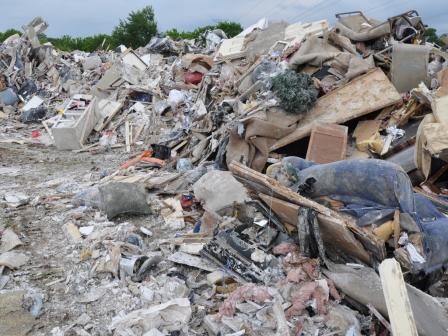Northeast Indiana Counties Collaborate to Develop Debris Management Plans

The potential for an increase in the frequency and severity of storms has spurred many communities to consider how they can safely and effectively manage an increase in the resulting disaster debris.
Key components of developing disaster debris management plans include selecting transportation routes and debris staging areas. As communities face the potential of changing environmental conditions, planning with data-informed resilience and rapid recovery in mind can help ensure disaster debris management plans are designed to be less vulnerable to hazards and impacts from storms.
Anticipating the increased need of disaster preparedness, several Northeast Indiana counties—Noble, LaGrange, Steuben, and DeKalb—developed debris management plans with the Northeast Indiana Solid Waste Management District (NISWMD). The planning process comprised of:
- A series of scoping meetings among key stakeholders including:
- County emergency management agencies.
- NISWMD.
- County highway officials.
- Additional elected officials.
- Identifying existing local, state and federal resources for developing a plan.
- Benchmarking debris management plans from other counties.
- Reviewing relevant federal and state guidelines.
The resulting county-level plans addressed:
- Management and storage options, including recycling and composting.
- Geographic Information System (GIS) maps identifying vulnerable transportation routes.
- Potential removal and transportation contractors, including those outside of the counties to ensure anticipated capacity needs.
- A tracking system to ensure debris was managed as desired.
To address the importance of timely execution following a disaster event, the plans include training and key materials such as checklists, job descriptions, and site “Deployment packages.” Site deployment packages consist of vital details such as maps, phone numbers, and specific instructions.
The debris management plans established by Noble, LaGrange, Steuben, and DeKalb Counties are living documents. The plans are constantly updated as the parties learn more information and find new opportunities to improve.
| How did they do it? | Applicable EPA Tools |
|---|---|
Step #1: Held a series of stakeholder meetings. County emergency management agencies, highway departments, and elected officials met with the NISWMD to develop a method for developing each county’s Disaster Debris Management plan. | To help communities prepare, EPA provides disaster debris planning resources. |
Step #2: Assessed the local adaptive capacity.
| EPA’s Planning for Natural Disaster Debris guides communities to create resilient disaster debris management plans. The Regional Resilience Toolkit helps regions plan for disasters, such as those caused by more frequent and intense storms. By working across multiple jurisdictions and with nongovernmental partners, data and lived experiences can provide a wealth of perspectives for effective planning and preparedness. |
Step #3: Developed Resilient Disaster Management Plans.
| FEMA’s Debris Management Plan Workshop helps State, Tribal and local governments and private NGOs to take proactive approaches to managing debris removal operations.* Having a FEMA-certified plan enables the jurisdiction to receive up to 90 percent of cleanup operation costs in a disaster for which the President of the United States issues a major disaster declaration. View the Public Assistance Debris Management Guide (PDF)(260 pp, 15 MB, About PDF).* *NOTE: Not an EPA Tool |
Similar Cases and More Information
Additional ARC-X case studies related to debris management are not yet available.
